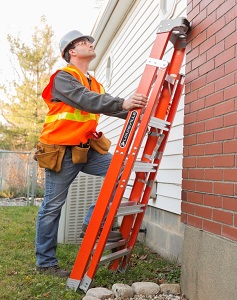How to use a ladder
Ladders are commonly-used low-risk and short-duration tasks at height. Safety requirements related to ladders are set out in Schedule 6 of the Work at height regulations 2005, and stipulate that ladders can be used when a risk assessment has shown that other equipment is not necessary because of the low risk (eg the ladder will be level and stable), and short duration (generally, less than 30 minutes).
Ladders should be checked for any defects before use. The stiles should not be damaged, the feet should not be missing or worn (as this can cause the ladder to slip), rungs should not be loose, worn or missing; and locking mechanisms should be functioning correctly.
Ladders should not be used on moveable, wet, icy, unstable or snow-covered surfaces, or within 6 m of an overhead power line. The pictogram or label on the ladder should be checked to ascertain the maximum weight that it can hold.
General safety precautions for using a ladder include:
- Positioning the ladder at 75° - the ‘1 in 4 rule’ (i.e. if the ladder is 4 m tall, the base should be 1 m from the building).
- The feet of the ladder should be sat firmly on the ground with timber blocks stacked beneath if the ground is not level.
- It should not be rested against upper surfaces that are weak or likely to break, such as glazing or guttering.
- Users should face the ladder when ascending and descending.
- Both hands should be used to hold the rungs.
- Three points of contact should be maintained when climbing (1 hand and 2 feet, or 2 hands and 1 foot).
- The ladder should not be ascended higher than the fourth rung from the top.
- A tool belt or holster should be used to carry tools and other equipment.
- The hips of the user should be within the vertical side rails without leaning to one or other side.
- The ladder should not be moved or extended while standing on the rungs.
- If necessary, or if used to access another level, ladders should be secured using ties.
- If the surrounding area is busy or in a public space (such as on a pavement), a suitable barrier or cones may be necessary as protection.
- A self-closing gate may be used at ladder access points.
[edit] Related articles on Designing Buildings Wiki
- Crane regulations.
- Hoists.
- Ladder.
- Lifting platform.
- Mobile elevating work platforms (MEWPs).
- Scaffold register.
- Scaffolding.
- Types of scaffolding.
- Work at height checklist for managers.
- Work at height.
- Working at height - our duty to prevent harm and protect each other.
- Work at height regulations.
- Working at height training.
- Working platform.
[edit] External references
Featured articles and news
RTPI leader to become new CIOB Chief Executive Officer
Dr Victoria Hills MRTPI, FICE to take over after Caroline Gumble’s departure.
Social and affordable housing, a long term plan for delivery
The “Delivering a Decade of Renewal for Social and Affordable Housing” strategy sets out future path.
A change to adoptive architecture
Effects of global weather warming on architectural detailing, material choice and human interaction.
The proposed publicly owned and backed subsidiary of Homes England, to facilitate new homes.
How big is the problem and what can we do to mitigate the effects?
Overheating guidance and tools for building designers
A number of cool guides to help with the heat.
The UK's Modern Industrial Strategy: A 10 year plan
Previous consultation criticism, current key elements and general support with some persisting reservations.
Building Safety Regulator reforms
New roles, new staff and a new fast track service pave the way for a single construction regulator.
Architectural Technologist CPDs and Communications
CIAT CPD… and how you can do it!
Cooling centres and cool spaces
Managing extreme heat in cities by directing the public to places for heat stress relief and water sources.
Winter gardens: A brief history and warm variations
Extending the season with glass in different forms and terms.
Restoring Great Yarmouth's Winter Gardens
Transforming one of the least sustainable constructions imaginable.
Construction Skills Mission Board launch sector drive
Newly formed government and industry collaboration set strategy for recruiting an additional 100,000 construction workers a year.
New Architects Code comes into effect in September 2025
ARB Architects Code of Conduct and Practice available with ongoing consultation regarding guidance.
Welsh Skills Body (Medr) launches ambitious plan
The new skills body brings together funding and regulation of tertiary education and research for the devolved nation.
Paul Gandy FCIOB announced as next CIOB President
Former Tilbury Douglas CEO takes helm.
UK Infrastructure: A 10 Year Strategy. In brief with reactions
With the National Infrastructure and Service Transformation Authority (NISTA).























